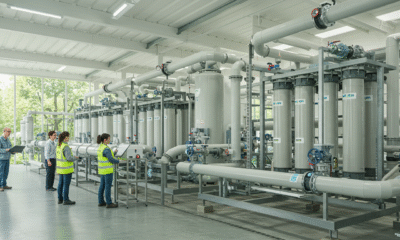

Environment
3 Ways Manufacturers Are Adopting Eco-Friendly Packaging
Packaging is a major financial and environmental cost in the modern world. Everything from food in supermarkets to mailed parcels requires significant packaging, and most of us deal with it many times per day. This leads to an environmental need for eco-friendly packaging. Packaging involves inks, papers and plastics, and other common compounds.
With such high usage, it’s easy to see the need for more sustainable packaging practices and materials. While there’s still significant room for growth in this sector, many businesses are already adopting more ecofriendly packaging policies. These are some of the easiest ways to reduce your ecological footprint.
Switching to environmentally friendly inks
Every ink contains a number of distinct substances, and a variety of chemicals can be used. One particularly destructive part of the ink is the solvent, which has led to companies using more eco-friendly materials in their solvents. Low Volatile Organic Compound (VOC) fluids help reduce the ink’s environmental impact, and VOCs are often regulated.
More and more ink producers are turning to environmentally friendly solutions, so there is now a wide selection of green inks. The ink manufactured by Videojet, for example, offers an alternative to traditional solvents include substances like water, acetone, and ethanol. Whether you’re printing on containers of food, industrial parts, or anything else, there’s a green ink that’s designed to meet your needs.
Fast-drying inks contain acetone, which makes them completely free of VOCs. This makes them a common choice for companies with strong environmental initiatives or more strict regulatory requirements. Some modern inks can be used to print directly on an item rather than on a separate label, which allows for further environmental savings.
Adopting responsible packaging practices
While companies may have been less conscious of this and similar issues in the past, modern consumers expect businesses to be environmentally conscious. Reflecting this attitude in your policies will improve your branding as well as your ecological impact, making responsible packaging a natural choice.
Reducing the footprint of your packaging is a relatively simple process based on principles with which we’re all familiar: reduce, reuse, and recycle. If any part of your packaging isn’t playing a vital role in some aspect of distribution, you should try to eliminate it. Similarly, you can promote reusing both internally and among your customers (think returning glass bottles, for example).
Finally, making as much of the packaging recyclable as possible demonstrates your commitment to the environment. Make it easy for your customers by marking the recyclable and non-recyclable sections of your packaging. These three steps will end up having a surprisingly significant effect on your company’s environmental impact as well as its branding.
Improving waste management
Going along with responsible packaging is waste management, which affects your business at every level. Wasted materials are a substantial environmental and economic cost, and it’s surprisingly easy to make progress toward eliminating it. Cutting down on waste will save time and money in addition to appealing to forward-thinking customers.
The first step to an efficient waste management program is effectively training all employees and informing them of your practices. You can also receive valuable feedback from different types of employees who may offer a unique perspective on new ways to cut down on wasted materials. Remember, waste management is a company-wide issue!
In the same way, that job performance is incentivized through recognition and rewards; you can recognize employees who demonstrate a real commitment to environmental issues. This will also show your employees that you’re not just doing this for the PR. Employees are more productive and engaged when they feel valued by management.
Packaging is just one aspect of a company’s operations, but cutting down on packaging waste can have a tremendous impact on environmental degradation and use of resources. Implementing these steps and others in your business will lead to change over time as employees become more conscious of your efforts. Environmental conversation is an essential issue for all of us, and companies have the opportunity to lead by example.


 Environment10 months ago
Environment10 months agoAre Polymer Banknotes: an Eco-Friendly Trend or a Groundswell?

 Environment11 months ago
Environment11 months agoEco-Friendly Home Improvements: Top 7 Upgrades for 2025

 Features9 months ago
Features9 months agoEco-Friendly Cryptocurrencies: Sustainable Investment Choices

 Features10 months ago
Features10 months agoEco-Friendly Crypto Traders Must Find the Right Exchange





























